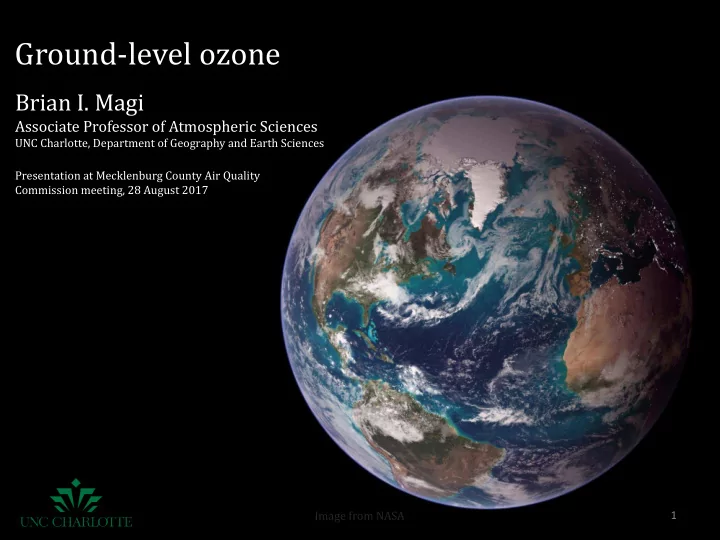

Ground-level ozone Brian I. Magi Associate Professor of Atmospheric Sciences UNC Charlotte, Department of Geography and Earth Sciences Presentation at Mecklenburg County Air Quality Commission meeting, 28 August 2017 Image from NASA 1
Picture of ground-level ozone (it’s invisible) 2
Air pollution kills 3 million people per year worldwide. Diabetes kills 1.5 million. AIDS kills 1 million. Malaria kills 450,000 . Air pollution kills more people than diabetes, AIDS, and malaria combined! Sources: http://www.who.int/mediacentre/news/releases/2016/air-pollution-estimates/en/ http://www.who.int/features/factfiles/malaria/en/ http://www.who.int/gho/hiv/en/ http://berkeleyearth.org/air-pollution-and-cigarette-equivalence/ Image from wikipedia 3
EPA Criteria Pollutants Concentrations from the National Ambient Air Quality Standards (NAAQS) that are scientifically determined to minimize harmful air quality Pollutant Primary/ Averaging Level Form Secondary Time 8-hour 9 ppm Carbon Monoxide Not to be exceeded more than once per primary year 1-hour 35 ppm Rolling 3 Lead primary and month 0.15 μ g/m 3 Not to be exceeded secondary average Nitrogen Dioxide 98th percentile of 1-hour daily maximum primary 1-hour 100 ppb concentrations, averaged over 3 years Ozone primary and Annual fourth-highest daily maximum 8- 8-hour 0.070 ppm secondary hr concentration, averaged over 3 years PM2.5 primary 24-hour 12 μ g/m 3 Annual mean, averaged over 3 years Particle Pollution (Particulate Matter primary and Not to be exceeded more than once per or PM) PM10 24-hour 150 μ g/m 3 secondary year on average over 3 years Sulfur Dioxide 99th percentile of 1-hour daily maximum primary 1-hour 75 ppb concentrations, averaged over 3 years 4
Determining the AQI relative to NAAQS Convert to AQI AQI Pollution Values Level Highest 0 to 50 Good AQI at that 51 to Moderate Measure 100 Every particular Unhealthy pollutant 101 to pollutant has for Sensitive 150 time is the Groups concentration its own AQI 151 to reported Unhealthy 200 AQI 201 to Very 300 Unhealthy 301 to Hazardous 500 5
Three main types of smog: 1. Smoky fog (smog) or the classic London Smog 2.Photochemical (ozone) smog 3. Particle (PM2.5) smog This is particle smog in Beijing 6
Ozone is NOT EMITTED . Ozone forms via gas chemistry that is completely dependent on nitrogen dioxide ( 𝑂𝑃 2 ) 𝑂𝑃 2 + 𝑡𝑣𝑜𝑚𝑗ℎ𝑢 → 𝑂𝑃 + 𝑃 𝑃 + 𝑃 2 + 𝑁 → 𝑃 3 + 𝑁 𝑃 3 + 𝑂𝑃 → 𝑂𝑃 2 + 𝑃 2 𝑂𝑃 2 This chemistry shows that 𝑃 3 depends on the ratio of 𝑂𝑃 If 𝑂𝑃 2 increases more than 𝑂𝑃 , then 𝑃 3 will increase, but 𝑃 3 itself is destroyed by reaction with 𝑂𝑃 . These reactions help explain background 𝑃 3 but not pollution levels . 𝑃 3 𝑂𝑃 2 𝑂𝑃 7
The key to understanding photochemical smog is to introduce new chemical pathways that convert 𝑂𝑃 to 𝑂𝑃 2 without destroying 𝑃 3 (big red arrow) 𝑃 3 𝑃 3 𝑂𝑃 2 𝑂𝑃 2 𝑂𝑃 𝑂𝑃 New chemical pathways 8
The key to understanding photochemical smog is to introduce new chemical pathways that convert 𝑂𝑃 to 𝑂𝑃 2 without destroying 𝑃 3 Bring in the humans! New chemical pathways are introduced when: VOCs and NOx concentrations 𝑃 3 increase in the presence of sunlight 𝑂𝑃 2 *Volatile organic compounds and NOx is NO2 and NO (nitrogen oxides) 𝑂𝑃 𝑊𝑃𝐷𝑡 break down chemically and are then oxidized by 𝑂𝑃 to form 𝑂𝑃 2 9
As 𝑂𝑃 2 increases, then the pathway to 𝑃 3 increases in strength and we get smog! 𝑃 3 𝑂𝑃 2 𝑂𝑃 𝑊𝑃𝐷𝑡 break down chemically and are then oxidized by 𝑂𝑃 to form 𝑂𝑃 2 10
VOC concentration NO concentration NO2 concentration Daytime: Ozone increase follows an NO2 increase Ozone concentration Overnight: Ozone is depleted by NOx 11
Mecklenburg County Winds typically blow from SW to NE VOCs and NOx are produced in center city Transport means highest O3 should develop downwind Charlotte-Douglas University Meadows (Ozone) Garinger H.S. (Ozone, PM2.5, NO2, CO, SO2) Remount Road (PM2.5, NO2, CO) Montclaire E.S. (PM2.5) Check air quality at https://www.mecknc.gov/LUESA/AirQuality/Air-Quality- Data/Pages/default.aspx and UNC Charlotte Urban Institute, Wikipedia, and Mecklenburg 12 County Air Quality “Mobile Source Indicators” report for various county stats 2014.
Mecklenburg County Snapshot Stationary sources – what we see being permitted at AQC (facilities, manufacturing, etc.) Area sources – include a wide variety of mostly stationary sources, and sometimes (but not always) permitted. Examples include dry cleaners, gas stations, lawnmowers, BBQs. …Restaurants (I think) Mobile sources – planes, trains, automobiles, etc. The number 1 problem! Figure is based on data in the very useful 2012 AQC report available at: https://www.mecknc.gov/luesa/airquality/educationandoutreach/pages/aqc.aspx 13
Great webpage of recent AQI: https://www.mecknc.gov/LUESA/AirQuality/Air-Quality-Data/Pages/recent.aspx 14
Useful interactive tool for seeing how pollution, meteorology, and human activities interact: Smog City! (not the brewing company in LA link)*. Smog city program is at http://www.smogcity2.org/ 15
Summary • Ozone is not emitted • Ozone forms as a biproduct of NO2 breakdown by high temperatures and sunlight • NO2 itself increases via VOC breakdown • Ozone forms during the day • Transport of precursors (NOx and VOCs) can cause ozone to form downwind • Ozone precursors are mainly emitted by mobile sources • Ozone pollution is only aspect of any pollution event Email if you have any questions brian dot magi at uncc.edu 16
Recommend
More recommend